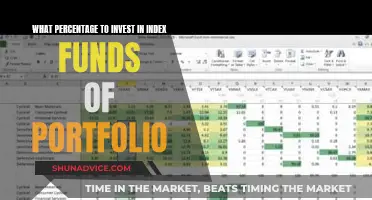
When it comes to investing, safety is a key consideration. While all investments carry inherent risks, some options are designed to minimise potential losses while still offering the opportunity for capital gains. For those seeking a conservative approach to investing, mutual funds can be an attractive option. With a diverse range of funds catering to different risk profiles and investment goals, Fidelity is a leading provider in this space.
Fidelity's conservative funds are designed for investors who want to minimise the impact of market fluctuations by taking a cautious approach, focusing on income generation with some potential for capital appreciation. By investing in a mix of stocks, bonds, and other securities, these funds offer diversification to reduce risk and increase the chances of achieving long-term goals.
So, what are some of the safest Fidelity investment funds? Here are a few options to consider:
- Fidelity Treasury Money Market Fund (FZFXX): This fund invests primarily in short-term, high-quality US Treasury bills and repurchase agreements, maintaining a stable net asset value per share of $1.
- Fidelity Total Bond Fund (FTBFX): With a relatively low risk and return profile, this fund invests in various types of debt securities, including US government and corporate bonds, offering diversification within the fixed-income space.
- Fidelity Growth & Income Portfolio (FGRIX): This fund seeks to balance income generation and capital appreciation by investing in dividend-paying stocks, as well as value and growth stocks. It has a moderate expense ratio of 0.59%.
- Fidelity Low Volatility Equity Funds: These funds are designed to help investors balance their portfolios in volatile markets by investing in stocks with lower risk than the broader market, potentially avoiding significant swings in their investments.
| Characteristics | Values |
|---|---|
| Name | Fidelity Treasury Money Market Fund |
| Type | Money market fund |
| Risk | Conservative |
| Historical volatility | Low |
| Drawdowns | Low |
| Focus | Short-term, high-quality instruments |
| Instruments | U.S. Treasury bills and repurchase agreements |
| Net asset value per share | $1 |
What You'll Learn

Low volatility investing
Fidelity offers several low volatility investment options, including:
- Minimum Volatility ETFs (Min Vol ETFs): These ETFs attempt to reduce exposure to stock market volatility by tracking indexes that aim to provide lower-risk alternatives. Min vol ETFs can be constructed in various ways, such as by holding a diverse mix of investments or defensive-leaning investments. While they do not eliminate risk, they can help reduce the potential for losses during market downturns. Examples include iShares MSCI Min Vol USA ETF and Invesco S&P 500 Low Volatility ETF.
- Fidelity® Low Volatility Factor ETF: This ETF seeks to invest in companies that have lower volatility than the broader market, helping to reduce overall portfolio risk.
- Fidelity® US Low Volatility Equity Fund: This fund aims to minimise volatility risk in down markets while benefiting from up markets.
It's important to note that low volatility investing does not guarantee against losses, and these investments may underperform during strong market conditions. Additionally, investors who rely too heavily on low volatility strategies may end up with portfolios concentrated in large-cap defensive stocks and light on small-cap growth stocks.
Hedge Funds: Why Investors Still Find Them Attractive
You may want to see also

Low expense ratios
When it comes to investing, fees are a consistent drag on net returns year after year. Therefore, choosing funds with the lowest fees is a straightforward way to ensure that more of your investment goes toward compounding growth rather than costs.
Fidelity ZERO Large Cap Index Fund (FNILX)
FNILX has a 0% expense ratio and no minimum investment requirement. It seeks to provide investment results that correspond to the total return of a broad range of large-capitalization U.S. companies. FNILX has outperformed its stablemate during the prior one, three, and five years. It has a superior "economic moat" rating by Morningstar, indicating that its holdings can fend off rivals for the next 10 years. Top holdings include Microsoft, Apple, Nvidia, Amazon, Alphabet, Meta, Berkshire Hathaway, and Eli Lilly.
Fidelity ZERO Total Market Index Fund (FZROX)
FZROX also has a 0% expense ratio and no minimum investment requirement. It seeks to provide investment results that correspond to the total return of a broad range of publicly traded companies in the US. FZROX allocates 8% of its shareholder money to small caps, while FNILX has zero small-cap allocation. This fund is a good choice for investors looking for broad exposure to the US stock market at a low cost.
Fidelity NASDAQ Composite Index Fund (FNCMX)
FNCMX has a net expense ratio of 0.29%, which is still considered low compared to other funds tracking the NASDAQ Composite Index. This fund had over $15 billion in assets at the end of the first quarter of 2024. It is a good option for investors looking for exposure to the technology and communications sectors.
Fidelity ZERO International Index Fund (FZILX)
FZILX has a 0% expense ratio and no load. It seeks to provide investment results that correspond to the total return of foreign developed and emerging stocks. This fund tends to stick with larger global names to limit risk. It is a good choice for investors looking for international exposure at a low cost.
Fidelity 500 Index Fund (FXAIX)
FXAIX has a net expense ratio of 0.015%, making it one of the lowest-cost investments in the mutual fund universe. For every $1,000 invested, Fidelity charges only 15 cents per year in fees. This fund provides exposure to the well-known S&P 500 index and is one of Fidelity's longest-tenured offerings. It has delivered an 11.04% annualized return since its inception in February 1988.
Fidelity Total Market Index Fund (FSKAX)
FSKAX has a net expense ratio of 0.015% and tracks the Dow Jones U.S. Total Stock Market Index. It holds over 3,800 market-cap-weighted domestic companies, providing broad exposure to the US stock market at a low cost. This fund is a good choice for investors looking for a low-cost, passive investment in the aggregate US stock market.
Longevity Fund: Investing in a Future of Long Life
You may want to see also

Broad diversification
Fidelity offers a wide range of mutual funds that provide broad diversification, catering to investors with different risk tolerances and investment goals. Here are some examples of Fidelity mutual funds that offer broad diversification:
Fidelity Total Market Index Fund (FSKAX)
FSKAX is a mutual fund that tracks the Dow Jones U.S. Total Stock Market Index, providing exposure to a wide range of U.S. stocks, including large-, mid-, and small-cap stocks. While most of its holdings are in large-cap stocks, it offers greater diversification than funds that solely focus on the S&P 500, such as the Fidelity 500 Index Fund (FXAIX). FSKAX has a very low expense ratio and a long performance history dating back to 1997.
Fidelity International Index Fund (FSPSX)
FSPSX is a mutual fund that offers diversification into international stocks from developed markets. It tracks the Morgan Stanley Capital International Europe, Australasia, and Far East Index, providing exposure to countries like Japan, the U.K., France, Switzerland, Germany, Australia, and Singapore. This fund provides a way to diversify outside of the U.S. market and serves as a hedge against poor returns in the domestic market. FSPSX has a low expense ratio and low portfolio turnover.
Fidelity Emerging Markets Index Fund (FPADX)
For investors seeking diversification into higher-risk, higher-return international stocks, FPADX offers exposure to emerging markets. It tracks the MSCI Emerging Markets Index, including countries like China, Taiwan, India, Brazil, and South Africa. This fund provides a complementary investment to developed market funds and can be a hedge against stagnating U.S. or international markets.
Fidelity Global Ex-U.S. Index Fund (FSGGX)
FSGGX is a combination of FSPSX and FPADX, offering exposure to both international developed and emerging markets in a single fund. It tracks the MSCI ACWI (All Country World Index) ex-USA Index and is split between 72% developed markets and 28% emerging markets. This fund simplifies the task of creating a globally diversified portfolio and provides greater simplicity compared to holding two separate funds.
Fidelity Balanced Fund (FBALX)
FBALX is a balanced fund that invests in both stocks and bonds, providing a mix of growth and income. It typically consists of around 60% stocks and 40% bonds, making it suitable for investors seeking a relatively tranquil portfolio. FBALX has a long history, dating back to its launch in November 1986, and has delivered an average yearly return of about 9.5% since its inception.
When considering the safest Fidelity investment fund, it's important to remember that all investments carry inherent risks, and past performance does not guarantee future results. It's essential to carefully review the fund's prospectus, investment strategy, fees, historical performance, and risk profile to ensure it aligns with your investment goals and risk tolerance.
Muni Bond Funds: A Guide to Investing Wisely
You may want to see also

Historical volatility and drawdowns
One such example is the Fidelity Treasury Money Market Fund (FZFXX), which is considered one of the more conservative choices within Fidelity's offerings. This fund primarily invests in short-term, high-quality instruments like U.S. Treasury bills and repurchase agreements, backed by the full faith and credit of the U.S. government. As a result, it can maintain a stable net asset value per share of $1.
For investors who want to minimise the impact of market fluctuations while still seeking capital appreciation, Fidelity's conservative funds offer a balanced approach. These funds aim to generate income by investing in dividend-paying stocks and value and growth stocks, while also investing in international markets and bonds to varying degrees.
Additionally, bond funds, such as the Fidelity Total Bond Fund (FTBFX), can be a safer alternative to equities. This fund aims to generate high income by investing primarily in debt securities, including U.S. government and corporate bonds, and has a relatively low risk and return profile compared to equity funds.
When considering historical volatility and drawdowns, it's important to remember that past performance does not guarantee future results. However, by assessing factors like expense ratios, portfolio turnover, and historical returns, investors can make more informed decisions about the level of risk they are comfortable with.
Liquid Fund Investment: Axis Liquid Fund Guide
You may want to see also

Market risk
To mitigate market risk, investors can consider investing in low volatility funds, such as those offered by Fidelity. These funds aim to minimize volatility risk and provide a more stable investment option. For example, the Fidelity Low Volatility Factor ETF and the Fidelity US Low Volatility Equity Fund are designed to help investors balance their portfolios during volatile markets. By investing in companies with lower volatility than the broader market, these funds seek to reduce significant swings in investment values and improve returns over time.
Additionally, investors can consider diversifying their portfolios by investing in a range of asset classes, sectors, and investment strategies. This diversification can help spread out the market risk and reduce its impact on the overall portfolio. It is also essential for investors to conduct thorough research, assess their risk tolerance, and make informed investment decisions that align with their financial goals.
It is worth noting that while market risk is a significant consideration, there are also other risks associated with mutual funds, such as management risk and liquidity risk. Management risk refers to the potential for poor investment decisions by fund managers, which can lead to underperformance. Liquidity risk, on the other hand, relates to the ease of buying or selling mutual fund shares, which can vary depending on market conditions.
Hedge Funds: Private Investment Opportunities and Strategies
You may want to see also







